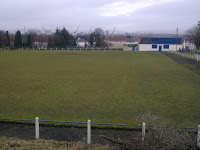Benburb FC are a junior or non league football club from the Govan district of Glasgow in Scotland who were formed in 1885. It is thought that the name derived from a village in Northern Ireland of the same name, as many Irish immigrants were involved in the club at time, with the club colours being green and white.
A merger with Crown Athletic was mooted in 1895 to form a new Oatlands FC but it fell down owing to differences in opinions of the time. Three years later the club changed their club colours to blue and white. Their Benburb Park home was lost, but the club found a new home at Govandale Park, the home of a former club called Linthouse.

In the early days 'Bens' produced many players who went on to play for Celtic before the club hit its heights around the 1930's, with success in the Scottish Junior Cup. The cup was lifted in 1934 and 1936 as Bridgeton Waverley and then Yoker Athletic were defeated. They also reached the finals of 1938 and 1943 before being beaten the first time by Cambuslang Rangers followed by disappointment as Kirkintilloch Rob Roy inflicted heartbreak after the tie went to a second replay. The West of Scotland Cup had been won in the previous two seasons before this epic.
The club had moved to Tinto Park in the shadows of Ibrox in 1932 as top quality players began their careers with Benburb. Frank Dunlop and George Johnstone who starred in the win against Yoker returned to Hampden Park the following season when they appeared for Aberdeen in the Scottish Cup Final in front of 137,000 fans against Celtic.
Jock Shaw began his career with Benburb before moving on to Airdrieonians, from where the legendary Bill Struth signed him for Rangers in 1938. Smith went on to a glittering career with the Ibrox club and Scotland before joining the coaching staff. Alex Forsyth appeared in the Benburb goal for seventeen years after a trial at Rangers came to nothing. John 'Eric' Smith moved from Bens to Celtic in 1953 and then on to Leeds United in 1960. Around this period Alex Ferguson was a regular at Tinto Park as a supporter cheering on his favourite player of the time Tommy Douglas.

Future Celtic legend Tommy Burns started his career as a goalkeeper at Tinto Park, before finding a midfield place more to his liking as he moved on to Maryhill. Benburb returned to Hampden for the 1980 Junior Cup Final, but they were overpowered on the big day by Baillieston. In the 1999-2000 season league honours were registered as the Central League title was clinched. After junior football reorganisation Benburb were placed in the same division.
Over the years Tinto Park was hit by vandalism and neglect after crowds dropped off after the boom post war years. However, this didn't stop the now Sir Alex Ferguson making a visit in 2010 to visit his old hero Tommy Douglas and the clubs committee and chat about the good old days before signing autographs and posing for pictures with the fans. Ferguson had attended the match when the record Tinto Park crowd of 20,000 turned out.
Benburb FC will compete in the SJFA Central Division One in the 2013-14 season.

My visit
Thursday 28th January 2010
Google maps had been a non stop source of assistance to me on my travels to various grounds in judging distances and finding my way around many new places. It was while I was working out a possible short cut by alighting from the train at Cardonald on my way back from a visit to St Mirren in Paisley to get to Ibrox. I noticed a football ground between the station and the stadium and after research I came across Benburb.
When the day in question came I ended up taking the Glasgow Subway to Ibrox. I couldn't get inside, but I took the ten minutes walk up Edmiston Drive and then Shieldhall Road before taking a turn up Craigton Road and Drive to the locked gates of the ground. This small obstacle wasn't to stop me from seeing inside.

The road led to an open field from where I was behind the south goal with an open view of the magnificent arena. I have subsequently read similarities being made with the old Champion Hill ground of Dulwich Hamlet and I could see that. Overgrown open terracing was behind the near goal and down the far side. The near side had a full length covered terrace with cinder stepping. The far end had a small overgrown bank and then the changing rooms and vandalised clubhouse in the corner by the entrance.
I walked away trying to visualise what the ground must have been like with all the terracing intact and huge crowds filling it at a time when the club was the pride of the community rather than a playground for mindless vandalism.
Hopefully the future would see the good times return to Tinto Park and offer rest bite to the heroic volunteers keeping the club going.





No comments:
Post a Comment